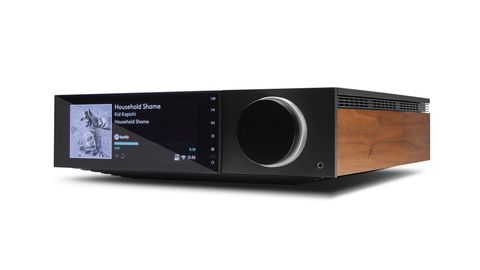Having spent more quality time with the Cambridge Audio Evo 75 in recent weeks than our colleagues in the past year, one thing sticks in our minds: this just-add-speakers streaming system is very good company. It doesn’t talk to us like many products do these days, and it doesn’t make us laugh (unless we’re playing “Weird Al” Yankovich through it). But it is pleasant to be around, and that’s because its design has been so well thought out.
The first evidence of this lies in its name. ‘Evo’ is a fitting one for a product that sits within a hi-fi category as progressive as this one, while the ‘75’ denotes its wattage-per-channel output. The Evo 75 is one half of Cambridge’s new two-strong Evo system offering, which includes a more extensively featured, 150W-per-channel model called – you guessed it – Evo 150.
Together, they mark Cambridge’s entrance into a burgeoning market of premium amplified streaming boxes that only require a set of speakers to form a complete system. It isn’t exactly a late debut, but it does come after those already made by the likes of Arcam, Linn, NAD and Naim.
Of course, Cambridge has a rich history in stereo amplification, as well as an established streaming platform on which its successful line of music streamers are based, so do the stars align when the two come together in one machine?
Features
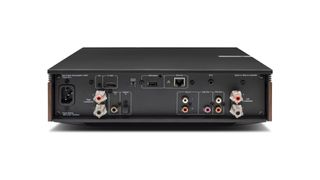
Today’s streamers are expected to be as extensively furnished as an IKEA showroom, and the Evo 75 is determined not to be out-featured at this level. Cambridge’s StreamMagic platform is an inviting gateway into streaming from Tidal, Qobuz and, via DLNA, any network-stored music drives.
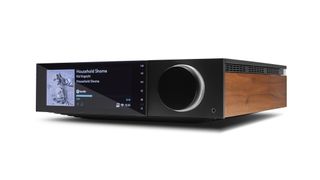
Outputs 3.5mm, preamp, sub
Inputs Coaxial, optical, RCA, USB, HDMI ARC, ethernet
Max power 75W per channel
AirPlay 2 Yes
Google Chromecast Yes
MQA Yes
Dimensions (hwd) 9 x 32 x 35cm
Spotify Connect and the new Tidal Connect (complete with MQA support for streaming hi-res Tidal Masters) are onboard to allow subscribers to play and control those services’ libraries from the native apps, while Google Chromecast offers native app playback for the likes of Deezer, YouTube Music, Apple Music and TuneIn Radio, too. AirPlay 2 allows one-touch casting from Apple devices, aptX HD Bluetooth offers an ‘offline’ streaming method, while support for Roon Ready completes a comprehensive streaming connectivity list.
The numerous ways in which you can stream music from your phone or tablet these days may seem daunting, but whichever route you decide to go down, the Cambridge won’t discriminate. There is also the opportunity to add external sources to the set-up, whether that’s a TV, CD player (Cambridge plans to launch an Evo CD transport later in the year) or storage drive, via the Evo 75’s RCA, USB, coaxial, optical and HDMI ARC sockets.
Turntable owners will notice no mention of a built-in phono stage – sadly, that’s not an oversight on our part. As well as delivering double the power output and featuring a different ESS Sabre DAC chip, the step-up Evo 150’s selling point is the inclusion of phono, asynchronous USB and balanced XLR inputs, a second optical input, plus two sets of speaker terminals for running two pairs of speakers simultaneously. Vinyl-loving Evo 75 owners will have to connect a deck with a phono stage to the RCA input, or buy a separate phono stage.
Build
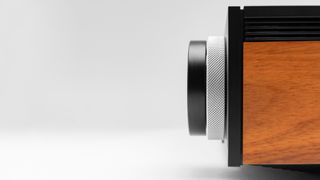
The one-box convenience of systems such as this has encouraged a more contemporary ‘lifestyle’ design ethos, and Cambridge has made the Evo 75 (and its aesthetically similar sibling) a beauty to behold.
Of course, beauty lies in the eye of the beholder, so Cambridge has found a way to appeal to more than one taste and living room decor. The black anodised aluminium chassis – somewhere between half and full-width chassis, measuring 31.7cm wide and about as deep – features magnetically attached side panels that can be swapped out at the owner’s discretion. The included panels are walnut wooden (a nod to Cambridge's first product, the P40 amplifier released in 1968) and an attractively corrugated material made primarily from a recycled paper called Richlite.
Whether your taste veers towards classic traditionalism or sleek modernity, the Evo deserves to be seen and not just heard. We’re particularly fond of the 6.8in LCD panel and dual-concentric rotary dial on the facade – these design elements are reminiscent of the company’s flagship Edge products.
The colourful panel prioritises album artwork and, providing you are close to the box, it’s easy to read the accompanying playback info (which includes file size and type) and menu settings. The dial comprises two parts: an outer wheel for browsing and navigating menus, which has a mechanical click, making it easy for you to be exact with your selections, and a more fluid inner volume wheel that’s smooth and responsive.
We’d like the dial to have a ‘select’ function when pressed, mind – it would feel more intuitive than reaching for the play/pause button or simply leaving it to automatically select.
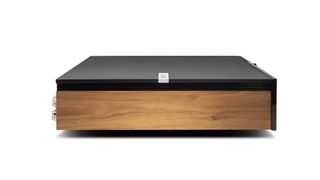
Those playback buttons on the right-hand side of the screen (for power, play/pause, track skip, changing the display format and switching between speaker and headphone output) are thin ‘strip’ keys that, while discreet, aren’t particularly nice to use. That’s not much of an issue, considering our everyday use of on-unit controls is limited, but note that they do also feature on the remote control.
That remote is a substantial tool – not the tiny credit-card style we sometimes see boxed with modern components – with a finger ridge on the rear that shows Cambridge values the small things. Its buttons mirrors the on-unit ones, also adding extra for display brightness adjustment and presets, however its angle of operation is quite narrow, so it doesn’t operate reliably if we’re too far off-centre from the Evo 75’s front panel.
Presets offer an easy way to access some of your favourite music sources, such as a particular internet radio station, and these can be allocated and selected either through the remote and within Cambridge’s StreamMagic app. However, note that not all music can be allocated; we couldn’t ‘preset’ an album from Tidal, for example.
As well as being useful during set-up and for accessing settings, the dedicated app is also on hand to navigate your local, USB or NAS libraries (it proves reliable and speedy for browsing multi-thousand-track libraries, albeit just in list format) and Tidal and Qobuz. You can also choose which sources to show and hide, and that will be helpfully mirrored on the Evo 75’s display menu to save you scrolling through the ones you don’t need.
If you are mostly streaming from native music streaming apps (via Chromecast, Spotify Connect, Tidal Connect or AirPlay 2) or a Roon user, you may not need the StreamMagic app – but it’s there, and reliable to use, if you do.
Sound
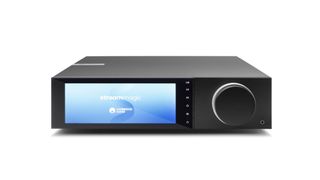
Cambridge’s efforts to tick boxes and create a satisfying user experience haven’t gone to waste. The Evo 75 is the sonic success its spec sheet deserves. It’s powered by third-party Hypex NCore Class D amplifiers, as opposed to the architecture Cambridge develops for its standalone amps, but, no doubt due to exhaustive tuning, it sounds no less ‘Cambridge’ for it – insightful, open and musical.
The clarity and breadth of the Evo’s soundstage are instantly apparent. We ease our way in with Penguin Cafe's At The Top Of The Hill, They Stood instrumental, and the Evo’s rendition is graceful at every turn. It's here we get our first hint of the Cambridge’s midrange articulacy, with a lovely fluidity and warmth to the melodious piano and melancholic strings.
There’s no shortage of room or attentiveness preventing either instrument from expressing itself dynamically – key in keeping you interested and involved in the piece – and as the soaring melodica comes in, no limitations in scale on the Evo’s part get in its way.
There's a rousing drive to Anderson .Paak's Come Home (feat André 3000) that’s complemented by a solid sense of rhythm, the Evo punctual and dynamic in its handling of the track’s buoyantly bluesy instrumental. And detail resolution is generous and spread evenly across the frequency range, too. André 3000’s rap cuts through tuneful bass notes and cutting cymbals with the fluidity the tempo demands, his cadence well communicated. While the Evo’s vocal delivery isn’t the last word in naturalness, it has a lush and solid character that’s hard not to like.
Similarly with Kate Bush's Babooshka, the Evo 75’s rendition has the punch and dynamic scrutiny to communicate the production’s jauntiness, as well as the transparency to get under both the delicate and dramatic moments of her eclectic delivery.
We plug the Grado SR325e and Meze Audio 99 Classics into the Evo’s front-panel 3.5mm output, which prompts the volume to automatically reduce (it returns to the previous speakers’ output level when they’re unplugged), and while it’s a cruder listen – there’s a slight loss of clarity and refinement – it’s still informative and entertainingly forthcoming.
Having started our listening with our reference ATC SCM50 speakers, we turn to the more price comparable, Award-winning KEF LS50 Meta and find they too play to the Evo’s strengths. Together their outlay isn’t insignificant – we’re talking around £2800 ($3750, AU$5500) – but for a system of this price, footprint and convenience, the level of performance they deliver is impressive. Even a partnership with the more affordable Bowers & Wilkins 607 S2 pleases: the presentation is more confined and bereft of the resolution and dynamic insight the KEFs can muster, but it’s still snappy, upbeat and ultimately likeable.
The multi-Award-winning Naim Uniti Atom demands a fairly sizeable premium over the Evo 75, and that price gap is indeed justified by its extra punch and rhythmic precision, as well as its ability to dig up a little more detail and present it in a soundstage that’s a touch clearer.
Verdict
There are now many streaming hi-fi products that sound great, look superb or are pleasant to use, but not many manage to nail all three as convincingly as the Cambridge Audio Evo 75. In the premium one-box streaming system market, nothing has before come this close to Naim’s Uniti range in offering the complete package.
If you’re looking for the ultimate convenience in a superb-sounding, well-featured parcel, and can’t stretch your budget to the Uniti Atom, the Evo 75 is simply the best system of its kind to spend quality time with.
SCORES
- Sound 5
- Features 5
- Build 5
MORE:
Read our guide to the best hi-fi systems
Read our Naim Uniti Atom review
Read our Arcam SA30 review
